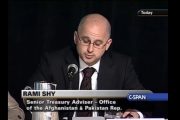
The FBI has reported that for the third straight year incidents of violent crime have declined across the United States. According to the federal police agency, violent crime declined by 5.3 percent during 2009, accompanied by a nearly five percent drop in property crimes.
The FBI study, which is derived from nearly 18,000 reports by government departments and college campus across the nation, found that among violent crime statistics for 2009, murder fell by 7.3 percent, robbery by eight percent, aggravated assault by over four percent, and rape by 2.6 percent. Nationally, approximately 1.3 million violent crimes were reported last year, which breaks down to less than 430 crimes for every 100,000 individuals.
As for property crimes, vehicle theft declined by slightly more than 17 percent, larceny by four percent, and burglary by 1.3 percent.
Many crime experts say the decrease is unusual, given that the nation is in the middle of a significant economic downturn. Richard Rosenfeld of the American Society of Criminology called the latest FBI report “one of these welcome puzzles,” telling the Associated Press, “This is forcing us to think more seriously under what conditions economic activity influences crime.”
Some analysts suggest the drop may be akin to that seen during the depths of the Great Depression, when crime rates remained low despite economic woes. “It’s kind of understood [that] if you’ve got an economic crisis that you’re likely going to see an upswing in property crimes,” Stephen Handelman of the Center on Media, Crime, and Justice at New York City’s John Jay College told the Christian Science Monitor. “Yet if everybody’s in the same bag, then individual neighborhoods are not necessarily as threatened as when you have sharp disparities in income, as you did in the 1990s.”
U.S. Attorney General Eric Holder attempted to tie the most recent crime decline to “investments in law enforcement” made by the Obama administration as part of its broad-ranging “economic stimulus” tax giveaway. “In 2009, the Obama administration provided over four billion dollars in support to law enforcement and criminal justice initiatives through the American Recovery and Reinvestment Act,” noted Mr. Holder, “including one billion in COPS funding to keep police officers on the street. He also tallied the $519 million in Byrne Justice Assistance Grants given to state and local police departments, boasting that in all, “These investments have helped maintain public safety and encourage new criminal justice innovations in state and local jurisdictions across the country.”
Apparently, however, Obama’s “investment” in crime-fighting didn’t find its way to areas where beefed-up law enforcement was most needed. While violent crime was down in suburbs and smaller communities, it was up in traditionally high-crime urban areas like Detroit, which reported a 2.2 percent increase in violent crime during 2009, with some urban areas bordering metro Detroit witnessing rates that exceeded four percent.
One criminologist, James Allen Fox of Northeastern University in Boston, noted that with murders increasing in places like Newark, New Jersey, and Baltimore, Maryland, the FBI data should be taken with a grain of salt. “Although homicides were down sharply in more affluent areas and among those 25 and over, the sound of gunfire was all too common in some poor neighborhoods,” he told CNN. “It’s not rosy everywhere.”
In fact, even while the White House and FBI officials were popping corks on celebratory champagne bottles, reveling in hundreds of millions of tax dollars well-”invested,” many urban Americans continued to huddle in fear, with African-Americans continuing to voice the greatest concern over crime in their neighborhoods. While blacks make up about 13 percent of the U.S. population, almost half of the 14,000 murder victims in 2009 were black, with a majority of the deaths occurring in urban centers.
Noted Handelman, “Even though globally crime is down and people sense that, they don’t necessarily feel safer. It depends on where you live.”



